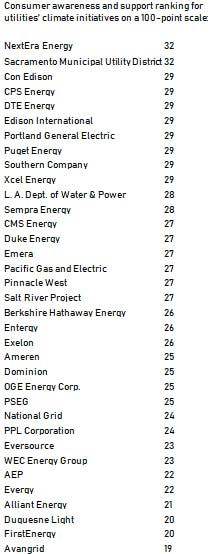In 2019, American states and electric utilities made more ambitious clean energy commitments than ever before, with leaders such as New York and California committing to hit 100% renewable energy targets by 2050. But responses from a first-of-a-kind survey of more than 34,000 business and residential customers found consumer awareness and support for electric utility climate sustainability initiatives is low.
Over the past 12 to 24 months there has been a flurry of announcements from energy utilities across the country, making commitments to meet aggressive environmental objectives over the next few decades. Over half of the nation's utility companies have publicly stated their intention to be carbon neutral by 2050 or sooner.
While the industry has done a good job of keeping institutional players informed of these developments, one group of stakeholders has been pointedly left out of this important flow of communication: ratepayers and citizens. Business and residential customers are largely in the dark about the major environmental initiatives being pursued by their utilities.
Troubling Data
The lack of green initiative awareness should be troubling. According to the latest J.D. Power survey on this issue, only 11% of customers are aware of their utility's clean energy initiatives. Utility customers in New York City (Con Edison), Los Angeles (Los Angeles Department of Water & Power), and Portland, Oregon, (Portland General Electric) have the highest levels of concern regarding climate change. While this is a national weighted average that reflects wide variation of customer awareness across the various brands, no utility scores high enough to say its customers are on board with its climate change initiatives.
On the high end of the spectrum, one utility has managed to constructively inform 32% of its customers about its significant environmental, social, and governance (ESG) plans. On the lower end, some organizations have managed to make only 2% of their ratepayers aware of plans to use clean energy.
Overall poor engagement with consumers on this issue is a problem for a number of reasons. It misses a short-term public relations opportunity, since clean and renewable energy initiatives tend to contribute positively to customer sentiment and utility satisfaction, according to our research. More importantly, however, the absence of customer awareness and engagement on ESG issues sets up long-term problems that will hamper utility efforts to execute plans to meet their stated objectives.
No matter how you look at any of the plans that have been recently announced, clean and renewable energy initiatives will have a significant effect on communities served by utilities. Citizens represented by public utility commissions (PUCs) will likely have to make important economic, civic, and infrastructural decisions — even concessions — before many of the announced carbon-neutral plans are put in place.
Significant capital investments will have to be made to create new infrastructures that reflect the decentralized architecture of future green energy grids. Beyond the money, communities will likely have to sign off on disruptions to neighborhoods to accommodate new generation sources and transmission and distribution (T&D) systems.
It is for this reason that utilities would be well-served to immediately engage, inform, and educate their customers about the complex issues that will have to be addressed for communities to enjoy the benefits of greener energy sources.
Current Consumer Attitudes About Green Energy
Consumers today are largely of two minds when it comes to clean energy. On the one hand, when consumers are made aware of clean energy initiatives, J.D. Power has documented that customer satisfaction increases by an average of 77 points on a 1000-point scale. That is the good news.
Here, however, is the bad news. As it currently stands, consumers do not appear to be particularly interested in spending a lot of their own money to help utilities make their operations greener. Our research shows that only 2% to 3% of consumers are willing to pay a higher "green rate" that guarantees the energy flowing into their homes comes from clean, renewable sources. The segment of the population that has expressed a willingness do this has, by and large, already done so.
A plurality of consumers (39%) tell us that they are currently unwilling to pay anything extra for green energy. Those who say they are open to paying more to pollute less (31%) are at most willing to spend an extra US$5 per month to do so. The revenues generated by these customers are nowhere near what will be needed to implement the most cost-effective carbon-free 2050 plan.
Launching a Green Consumer Engagement Campaign
While the numbers presented above are accurate representations of current consumer attitudes, we know from experience that these attitudes can shift — and do so dramatically — through effective engagement, education, and activation.
We also know that consumers are willing to learn. And on this front, it seems clear a lot of work needs to be done by the industry. Our research often captures consumer misconceptions about the economics of energy in general, and the pricing of clean and renewable electricity in particular. It is not unusual to capture verbatim comments that say, "Renewables such as wind and solar are free; I should be paying less not more!"
Similar dynamics were at play — albeit on a much smaller scale — with the shift from coal to natural gas. While this was a relatively straightforward change — existing infrastructure could often be reused by simply switching coal boilers to natural gas technology — a case for PUCs and ratepayers to help fund the transition had to be made. Even though the economics for retooling and transforming power plant infrastructure was compelling and clear, it has still taken 15 years to make the transition.
Clean energy goals are much more complicated and have significantly larger infrastructure cost implications. If it took a decade and a half for the coal to natural gas conversion to take place, then making the switch to clean energy by 2030, 2040, or 2050 will be a more formidable challenge. A failure to put in place a comprehensive, well designed, and persistent customer engagement strategy will make the challenge all the more difficult to overcome.



